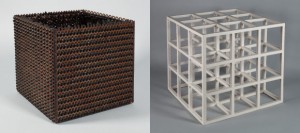
There are some interesting shows in the Uptown galleries in Manhattan this spring. Although Gagosian’s Kazemir Malevich and the American Tradition is a flimsy premise for a show—anything geometric by an American artist seems to qualify as being inspired by the pioneering Russian Constructivist painter—it is a large show with some great works, as well as some slight ones (980 Madison Avenue, through April 30). It is a rare opportunity to see seven Malevich paintings, including a Cubist one from 1913 and several classic Constructivist abstractions from 1916. Beyond that, the show includes a mediocre Dan Flavin in a corridor of its own (dark blue/purple fluorescent tubes that give off very little light, so what’s the point?) plus a spectacular Flavin installed in a small room of its own. Vertical blue tubes straddle a far corner facing the room, on top of horizontal red ones that face away: the room is dyed luminous blue, while intense flames up the corner walls. Other galleries include Richard Serra’s classic One Ton Prop, four immensely heavy sheets of lead supported by their weight leaning against each other, and one of his pointless black grease pencil rectangular drawings (to coincide with the show of his drawings that recently opened at the Metropolitan Museum a few blocks north). Always interesting and maverick Charles Ray shows a subtle and original black ink painting, and there are some trivial paintings by Ed Ruscha, along with two beautiful Don Judd sculptures, a great early Frank Stella notched silver striped painting opposite a large, somber, dark late Mark Rothko—just a dark gray rectangle within a deep purple frame, the purple creating complementary images of golden yellow on the gray.
Much more focused is a lovely little show of works by Eva Hesse and Sol Lewitt at the Craig F. Starr Gallery, (5 East 73rd Street, through May 27). Lewitt and Hesse were close friends, but while he had a long, prolific career, hers ended tragically with her death at age 34, so her output was limited.

This is a good opportunity see some fine examples, many from Lewitt’s personal collection, in an intimate setting. Although he is usually considered a geometrical Minimalist and she an organic Post-Minimalist, the resolutely abstract and materialist pieces in this show reveal the two artists had a lot in common–and in several of the modestly scaled works in the show they are at the top of their game.